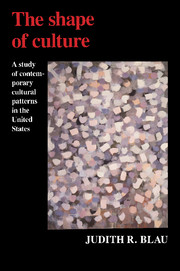Book contents
- Frontmatter
- Contents
- List of figures and tables
- Acknowledgements
- 1 Culture as structure and meaning
- 2 The American cultural landscape
- 3 Reproduction and decline
- 4 Co-occurrence, tipping in, and bridging
- 5 Organizational assembly and disassembly
- 6 Increasing returns on diminishing artists
- 7 A little more on the hobby horse
- 8 Masses and classes
- 9 The transformation of American culture
- Appendix A List of SMSAs and 1970 population in 100s
- Appendix B Sources and descriptions of cultural indicators
- Appendix C Log transformation
- Appendix D Polynomial term
- Index
- Other books in the series
1 - Culture as structure and meaning
Published online by Cambridge University Press: 06 July 2010
- Frontmatter
- Contents
- List of figures and tables
- Acknowledgements
- 1 Culture as structure and meaning
- 2 The American cultural landscape
- 3 Reproduction and decline
- 4 Co-occurrence, tipping in, and bridging
- 5 Organizational assembly and disassembly
- 6 Increasing returns on diminishing artists
- 7 A little more on the hobby horse
- 8 Masses and classes
- 9 The transformation of American culture
- Appendix A List of SMSAs and 1970 population in 100s
- Appendix B Sources and descriptions of cultural indicators
- Appendix C Log transformation
- Appendix D Polynomial term
- Index
- Other books in the series
Summary
Twenty men crossing a bridge,
Into a village,
Are twenty men crossing twenty bridges,
Into twenty villages,
Or one man
Crossing a single bridge into a village.
Wallace Stevens, “Metaphors of a Magnifico” (1918)Wallace Stevens makes an observation here that is simultaneously perplexing and profound. What is in certain terms considered to be complexly structured with intricate patterns and multiple meanings is, in other terms, considered to have a simple shape and singular meaning.
The relevance of this apparent paradox for the queries I raise here about culture is that it is shaped by many different objective conditions: spatial, social, economic, and organizational. Moreover, my conclusion draws attention to the contradiction that is intended: the very social conditions that shape institutionalized culture also erode distinctive cultural meanings as these meanings have become universal and are widely shared in modern society.
These considerations also raise questions about the conventional assumptions made in the social sciences about the nature of social and cultural patterns and the processes that govern them. Social scientists have emphasized one world view at the expense of others. We stress differences over uniformity, the multiple over the singular, structure over disorder, progression over retrogression. Whether understanding is sought through empirical study, theoretical explanation, or meaningful interpretation, the intricacies of the social fabric and the complexity of the processes that underlie change are relentlessly emphasized.
- Type
- Chapter
- Information
- The Shape of CultureA Study of Contemporary Cultural Patterns in the United States, pp. 1 - 9Publisher: Cambridge University PressPrint publication year: 1989



